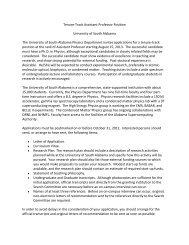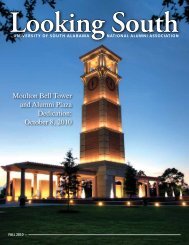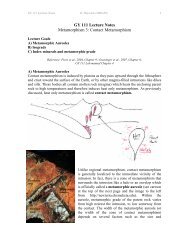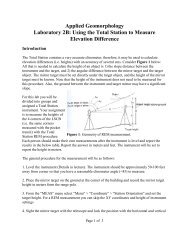Archaeological Survey of the Old Federal Road in Alabama
Archaeological Survey of the Old Federal Road in Alabama
Archaeological Survey of the Old Federal Road in Alabama
You also want an ePaper? Increase the reach of your titles
YUMPU automatically turns print PDFs into web optimized ePapers that Google loves.
More precise locations <strong>of</strong> <strong>the</strong> roads extend<strong>in</strong>g from Fort Stoddert to St. Stephens, Mobile, andNew Orleans can be determ<strong>in</strong>ed by exam<strong>in</strong><strong>in</strong>g Fletcher Hale’s map <strong>of</strong> Mobile County (Figure 3-9) and1938 aerial photographs. Hale was a county eng<strong>in</strong>eer <strong>in</strong> Monroe County whose passion throughout <strong>the</strong>late 1930s and 1940s was to trace <strong>the</strong> <strong>Old</strong> <strong>Federal</strong> <strong>Road</strong> as precisely as he could. He created a series <strong>of</strong>detailed maps <strong>of</strong> <strong>the</strong> road based largely on his <strong>in</strong>terpretations <strong>of</strong> roads and road traces visible on <strong>the</strong>ground and on aerial photographs taken <strong>in</strong> <strong>the</strong> 1930s and 1940s. So <strong>of</strong> course his maps correspond closelyto <strong>the</strong> road system visible on <strong>the</strong> 1938 aerial photographs available to us. We first compared <strong>the</strong> roadsidentified by Hale on his Mobile County map to <strong>the</strong> historic aerials, <strong>the</strong>n to modern aerial photographs.We also made adjustments to account for any alignment issues result<strong>in</strong>g from georeferenc<strong>in</strong>g his mapswith <strong>the</strong> aerial photos. Historic survey plats were consulted as well, but <strong>the</strong>y did not prove useful forMobile and Wash<strong>in</strong>gton counties, s<strong>in</strong>ce <strong>the</strong> earliest extant plats do not show roads. And, unfortunately,Hale did not map <strong>the</strong> <strong>Old</strong> <strong>Federal</strong> <strong>Road</strong> <strong>in</strong> Wash<strong>in</strong>gton County. Two roads cross<strong>in</strong>gs, however, arementioned <strong>in</strong> Seth Pease’s 1806 survey notes: an Indian Path on <strong>the</strong> western boundary <strong>of</strong> Section 19,Township 2 North, Range 2 West; and <strong>the</strong> Chickasawhay Path from <strong>the</strong> sou<strong>the</strong>rnmost Choctaw town toFort Stoddert, which crossed <strong>the</strong> eastern boundary <strong>of</strong> Section 14, Township 2 North, Range 2 West. 4Both po<strong>in</strong>ts fall along <strong>the</strong> same road head<strong>in</strong>g west to New Orleans from Fort Stoddert, which confirms <strong>the</strong>orig<strong>in</strong> <strong>of</strong> that historic road as an Indian path.Hale labeled <strong>the</strong> sou<strong>the</strong>rnmost section <strong>of</strong> <strong>the</strong> <strong>Old</strong> <strong>Federal</strong> <strong>Road</strong> <strong>the</strong> “<strong>Old</strong> River <strong>Road</strong>,” as it wasknown locally <strong>in</strong> <strong>the</strong> early twentieth century. He also identified a road runn<strong>in</strong>g west from NannahubbaIsland, where <strong>the</strong> <strong>Old</strong> <strong>Federal</strong> <strong>Road</strong> orig<strong>in</strong>ally crossed <strong>the</strong> Mobile-Tensaw delta, that connected with <strong>the</strong>road from Fort Stoddert to St. Stephens. This section <strong>of</strong> road is shown on <strong>the</strong> Bradley, Ludlow, Melish,and LaTourette maps.Today, <strong>the</strong> three historic roads extend<strong>in</strong>g from Fort Stoddert generally follow modern pavedroadways. The road to <strong>the</strong> south corresponds closely with U.S. Highway 43, which runs north fromMobile, through <strong>the</strong> small communities <strong>of</strong> Chickasaw, Satsuma, Axis, Salco, Bucks, Chestang, andMovico to Mount Vernon. West from Fort Stoddert, Military <strong>Road</strong>/Mobile County <strong>Road</strong> 96 to MountVernon Arsenal was part <strong>of</strong> <strong>the</strong> early route from Fort Stoddert to New Orleans. North toward St.Stephens, U.S. Highway 43 cont<strong>in</strong>ues through Calvert, Malcolm, Mac<strong>in</strong>tosh, Wagerville, and Leroy. InLeroy, Wash<strong>in</strong>gton County Highway 34 branches northwest to St Stephens. Modern U.S. Highway 43diverges <strong>in</strong> places from <strong>the</strong> <strong>Old</strong> <strong>Federal</strong> <strong>Road</strong>, especially <strong>in</strong> <strong>the</strong> immediate vic<strong>in</strong>ity <strong>of</strong> Fort Stoddert, whereFletcher Hale’s <strong>Old</strong> River <strong>Road</strong> corresponds much more closely than does U.S. Highway 43. All <strong>of</strong> ourhistoric maps show <strong>the</strong> <strong>Old</strong> <strong>Federal</strong> <strong>Road</strong> lead<strong>in</strong>g directly to Fort Stoddert, as does <strong>the</strong> <strong>Old</strong> River <strong>Road</strong>,while U.S. Highway 43 runs several miles west <strong>of</strong> Fort Stoddert.58
















